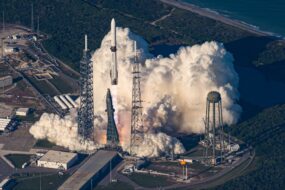In 2024, the Space Force’s Space Launch Delta 45 supported a record 93 launches from Cape Canaveral Space Force Station and Kennedy Space Center, the unit announced last week.
These launches—a 35% jump over the prior year—brought 1,389 assets into orbit, including a variety of satellites on SpaceX rideshares, the Crew-9 mission to the ISS, and four rockets as part of the National Security Space Launch program.
And they have no plans to slow down this year, with Guardians preparing for an “even higher launch cadence in 2025,” Brig. Gen. Kristin Panzenhagen, director of the Eastern Range, said in a statement.
Supply and demand: Despite the Space Force’s bold plans for 2025, many in the space industry believe that US launch capacity may be nearing its zenith—potentially leaving some in search of a ride to space out of luck.
“This is going to reach a crisis point here, probably in the next four years,” Phantom Space CEO Jim Cantrell told Payload. “I don’t think any new launch sites are coming to the shores of the United States [except] maybe Maine.”
New launch pads at existing facilities are set to handle the short term increase.
- SpaceX built a second launch tower at its Starbase launch facility in Texas.
- Elon’s launch giant is also increasing its footprint at KSC to stage Starship flights from the East Coast as soon as this year.
- NASA’s ML-2 at KSC to support SLS launches is still in production, despite scrutiny for cost and schedule overruns, and rumors of Trump shutting SLS down.
- The Maine Space Corporation has infrastructure to support suborbital launches but is looking to create an orbital launch facility in the next decade to support small launchers.
The bottom line: If US launch capacity peaks, some launch companies may look overseas to keep up with demand, either through maritime launch pads or the growing number of international launch sites, though it’s unclear if regulatory reform will rise to the occasion.




